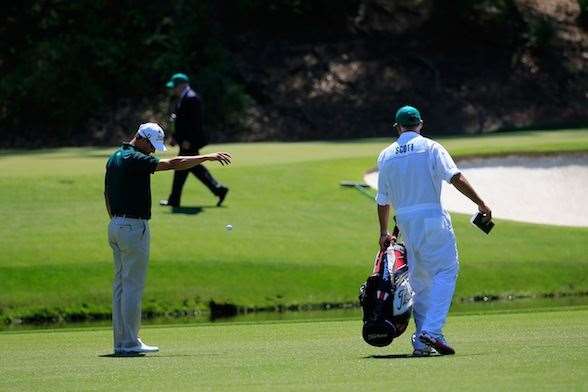Augusta National's par-3 12th hole, the shortest on the course, proved devilish for many during opening round of the Masters, as Brendan James reports
BY BRENDAN JAMES at Augusta National GC
In this bomb and gouge era where 300-yard drives are the norm rather than the exception, it was a wee par-3 that jangled the nerves and inflicted scorecard pain on the field during the opening round of the 2014 Masters.
The 155-yard 12th hole, known as Golden Bell, has gained a reputation over the years for its unforgiving nature and demands for precise ball-striking. Standing on the tee, players are protected from any breeze by a grandstand and the surrounding tall pines. You know the wind is there but it seems to swirl around above this basin at the heart of Augusta’s Amen Corner.
 A gusting wind made players indecisive on club selection during the first round. Some paid heavy penalties for their mistakes. PHOTO: Getty Images
A gusting wind made players indecisive on club selection during the first round. Some paid heavy penalties for their mistakes. PHOTO: Getty ImagesTo judge the wind, players normally look at the flag on the 11th green to get a sense of where the wind is coming from and then they make their club selection from there. Despite the 12th being the shortest hole on the famed layout, it is not a birdie hole.
The wide, shallow green is wedged between Rae’s Creek, in front, and two bunkers through the back. A lone bunker is also cut into the slope between the putting surface and the creek. Masters competitors talk of having to land their tee shot here in an area about the size of dining table in the middle of the green.
It has never been a hole easily dominated. There have been only three holes-in-one on the 12hole in Masters history – the last of those came from Curtis Strange in 1988. Eight years earlier, Tom Weiskopf notched up a 13, which remains a record high score for the hole.
In the first round, with the distance from tee to flag playing exactly 158 yards (or 144 metres), the world’s best golfers struggled to even par the hole.
At day’s end, the 12th hole was ranked the second hardest hole on the course at 3.42. Only the 505-yard (462-metre) par-4 11th proved more difficult at 4.47. The little 12th coughed up just six birdies in a field of 97. Little more than half of the field was able to find the green with their tee shots.
Former champion Ben Crenshaw made a triple bogey 6, a feat equaled by South African Branden Grace and young American amateur Jordan Niebrugge. Another eight players could do no better than a double bogey five, including defending champion Adam Scott, who dunked his 9-iron into Rae’s Creek for the first time in 13 Masters appearances.
 Adam Scott takes a drop of hitting his tee shot into Rae's Creek in the opening round. PHOTO: Getty Images
Adam Scott takes a drop of hitting his tee shot into Rae's Creek in the opening round. PHOTO: Getty ImagesHaving received a standing ovation from the gallery as he walked onto the tee, Scott, who was leading the tournament at four under at the time, then found the water.
“It's just that back right pin spot,” he said. “I wasn't even paying attention to it and it got me – I wasn't trying to hit it over there. But there was so little wind, it was probably a problem today, rather than when it's blowing all kinds of directions.
“I just lost a little focus on that shot and didn't commit fully to it and you pay a price on that one.
“It was a weak shot. The only weak shot I hit, and it's actually the first time I think I've ever hit it in that creek. So I’m going to move on tomorrow and put it behind me,” he chuckled.
Fred Couples, who has been playing this course for more than three decades, also got caught out on Golden Bell. It wasn’t the first time. Back in 1992 he under-clubbed his tee shot and it sat on the bank above the water line of Rae’s Creek. He managed to get up and down and go on to win the Green Jacket.
In the first round here, he couldn’t get a feel for the breeze and pulled his 8-iron into the back bunker. He had no shot at the flag and his only choice to avoid making a big number was to play away from hole. He finished with a bogey but it could have been worse.
“I know guys are screwing up on it a little bit, it's just a hard shot (the tee shot on 12),” Couples said. “If you don't hit a perfect shot into the wind on 12, it's going to come up short. If you're a little right, you're going to probably hit the bank and go in the water. Obviously, if you go left, you might get it in the bunker.
“But that's kind of the toughest shot you'll have for most of the day.”
Related Articles

Review: Clearwater Golf Club

Review: Omaha Beach Golf Club













